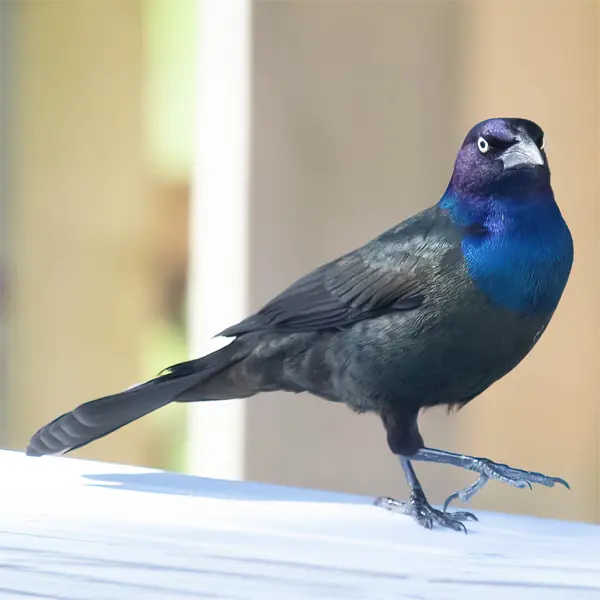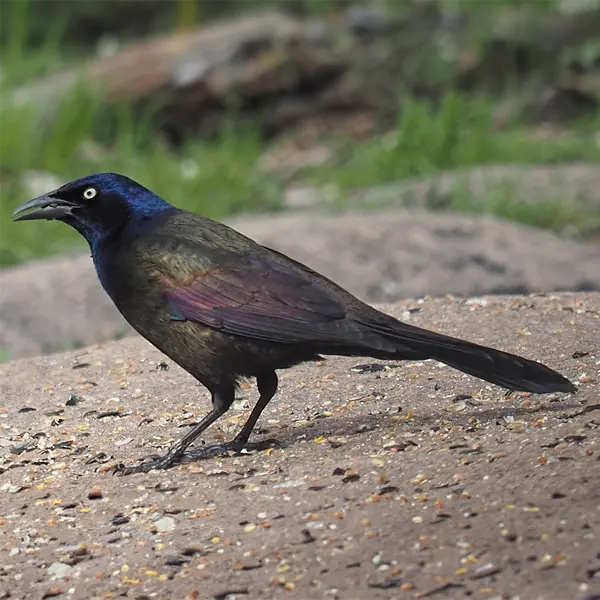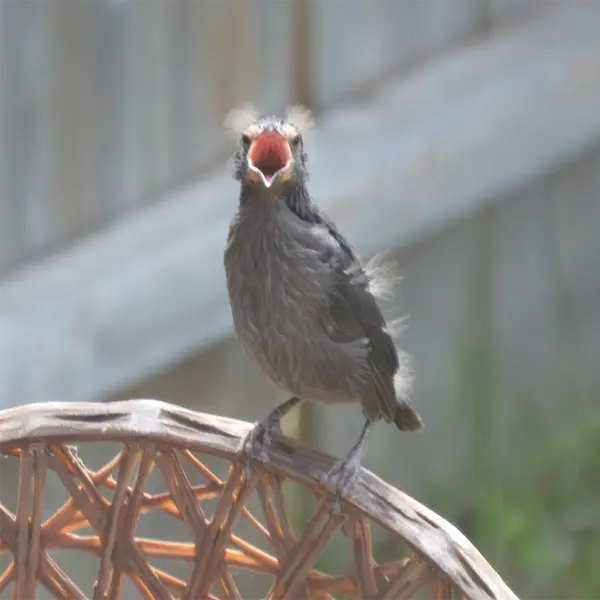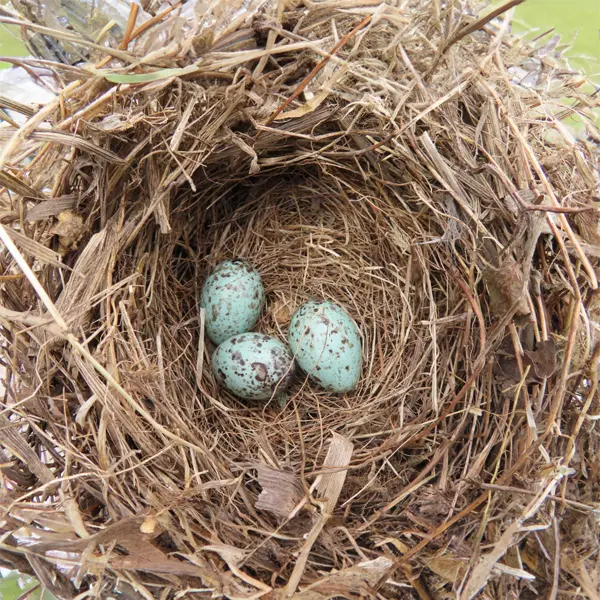Grackles
- Scientific Name
- Quiscalus quiscula
- Also Known As
- Crow Blackbird, Maize Thief
- Range
- All of Florida
- Diet
- Insects, Fish, Frogs, Eggs, Grains, Fruit
- Life Expectancy
- 5 - 12 Years
Quick Links
Grackles in Central Florida
The common grackle (Quiscalus quiscula) is a ubiquitous bird found throughout central Florida. Often considered a nuisance, grackles are highly adaptable and thrive in urban and suburban environments.
This comprehensive guide provides detailed identification tips, biology facts, and control methods for grackles in central Florida. Read on to learn grackle habits, reproduction, diet, health risks, signs of infestation, and professional mitigation options if you have an overabundance on your property.
Subspecies of Grackle in the Area
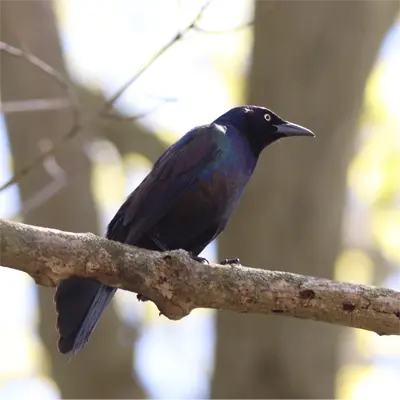
Photo 71703156 © Sequoia Janirella Wrens, CC BY-NC
The purple grackle is a unique subspecies of grackle found throughout Florida. Genetic evidence shows purple grackles evolved separately from other grackle populations. Their feathers have a distinctive iridescent purple, bronze and green sheen compared to the black plumage of other grackles.
Purple grackles are also smaller, around 11 inches long. Their smaller size and colorful feathers are likely adaptations for their habitat in tropical hardwood hammocks and mangroves.
Loss of these habitats has greatly reduced their range. Calling them a distinct subspecies stresses the need for habitat protection. Preserving remnant hammocks and mangroves is essential for the purple grackle’s survival.
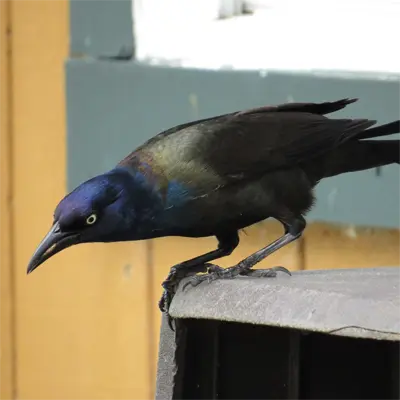
Photo 27156801 © rainbowkitten, CC BY-NC
The bronzed grackle is a unique subspecies found along Florida’s Gulf coast. Genetic evidence indicates bronzed grackles evolved separately. Their feathers have a distinctive bronzy-purple metallic sheen unlike other subspecies.
Bronzed grackles are also smaller, around 12 inches long. Their size and coloration are likely adaptations for coastal habitats like mangroves.
Loss of coastal wetlands has greatly reduced their limited range. Calling them a distinct subspecies emphasizes the need for habitat protection. Preserving remaining mangroves and marshes is critical for the bronzed grackle’s survival.
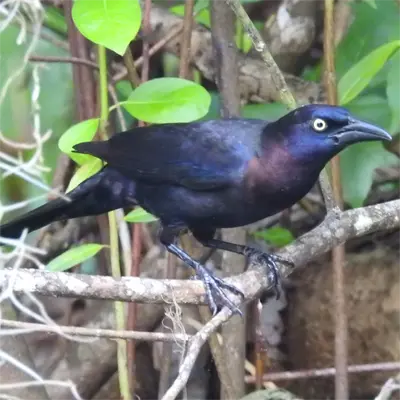
Photo 196441026 © JeffreyGammon, CC BY-NC
The Florida grackle is a unique subspecies found across Florida. Genetic evidence shows Florida grackles diverged from other populations long ago. They are larger than other subspecies, reaching 15 inches long.
Their size is an adaptation for more open habitats like pastures and parks versus forest. Florida grackles also have pale yellow eyes compared to white in other subspecies.
Habitat loss has reduced their range, but they remain common compared to rare coastal relatives. Calling them a distinct subspecies stresses the need to preserve their open habitats. Protecting remnant prairies and wetlands is important for the Florida grackle’s future.
Appearance and Identification
Grackles can be identified in both juvenile and adult plumages by their distinctive physical characteristics
Maturation Rate
Grackle chicks develop quickly after hatching. They are ready to fledge by 2 weeks old but remain dependent on the parents for several more weeks. Juveniles approach adult size by about 1 month post-fledging. Sexual maturity and adult plumage occurs within the first year after hatching.
Habits and Behavior
Grackles are highly social, foraging and roosting in large noisy flocks. They are active during the day and gather in communal roosts at night, sometimes with thousands of birds. Grackles walk on the ground in open spaces and perch prominently on wires, trees, and rooftops.
Their flight style is described as lazy and fluttering with the tail often fanned. Grackles produce a wide range of squealing, chattering, and clicking vocalizations. They are aggressive and often displace smaller birds from feeders and nest sites.
Reproduction and Lifespan
Grackles breed very prolifically, facilitated by the long nesting period. In central Florida, breeding can occur from February to July. Females build a basket-like nest secured with mud in trees, shrubs, or manmade structures. The typical clutch size is 3-5 eggs.
Incubation lasts 12-14 days and the altricial hatchlings fledge by 14-17 days old. Grackles produce 1-2 broods per breeding season. Lifespan ranges from 5 to 12 years in the wild. Their high reproductive potential allows grackle numbers to rapidly increase.
Ideal Habitat and Range
The warm, humid climate of central Florida provides ideal habitat for grackles to thrive year-round. Average temperatures range from the 60s°F (16°C) in winter to over 90°F (32°C) in summer. The rainy season lasts from June to September, delivering over 50 inches of annual rainfall.
Abundant sources of food, water, and nesting sites allow grackles to flourish in both natural and manmade environments. They frequent open grassy areas like fields, parks, and wetlands as well as suburban lawns, shopping centers, and landscaped areas. Grackles adapt readily to human activity and artificial food sources.
The high reproductive capacity, omnivorous diet, temperate climate, and availability of urban food waste like trash facilitate grackle overpopulation issues in central Florida neighborhoods. Exclusion of food sources and roosting sites is often needed to disperse large concentrations.
Diet and Feeding
Grackles are opportunistic omnivores and consume a wide variety of plant and animal matter. Staple foods include:
- Insects – grasshoppers, beetles, caterpillars, ants, wasps, etc.
- Grains – corn, oats, wheat, rice, bread crumbs, etc.
- Berries – juniper, dogwood, black cherry, etc.
- Fruits – oranges, bananas, melons, apples, etc.
- Nuts and seeds – acorns, peanuts, sunflower seeds.
- Small fish, crustaceans, mollusks when available.
- Carrion, scraps – feed on dead animals, roadkill, trash.
- Bird eggs and nestlings.
Grackles forage on the ground in open areas like lawns, plowed fields, and meadows. They also raid trash bins and bird feeders for scraps. Grackles obtain most of their water from food but will drink and bathe in puddles.
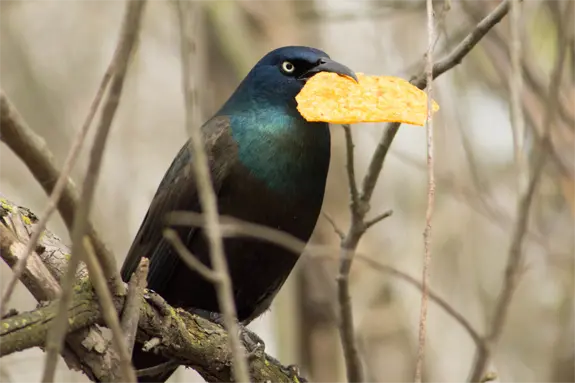
Photo 201162336 © Katrina Martin, CC BY-NC

Common Health Risks
Grackles can potentially transmit certain infectious diseases to humans through feces contamination:
- Salmonellosis – diarrhea, fever, abdominal cramps.
- Campylobacteriosis – diarrhea, cramping, fever, nausea.
- Cryptococcosis – fungal infection that can cause pneumonia.
- Histoplasmosis – lung infection from fungal spores in droppings.
Large amounts of grackle droppings around homes can lead to unsanitary conditions. Their loud communal roosts are also considered a nuisance. Use netting, metal spikes, habitat modification, and population control to mitigate problems.
Preventing Grackle Overpopulation
- Remove food sources – Secure trash and recycling bins. Remove pet food bowls, fallen fruit/berries, and spilled grain. Use bird feeders with weight-activated perches.
- Exclude roosting/nesting sites – Block access to patio overhangs, roof eaves, attic vents, etc. Use nets over ponds and water features. Trim back dense shrubs and trees.
- Install deterrents – Reflective tape, ultrasonic repellers, owl decoys, and water spray devices.
- Population control – Replace bird seed with treated corn. Live trap and relocate birds away from property.
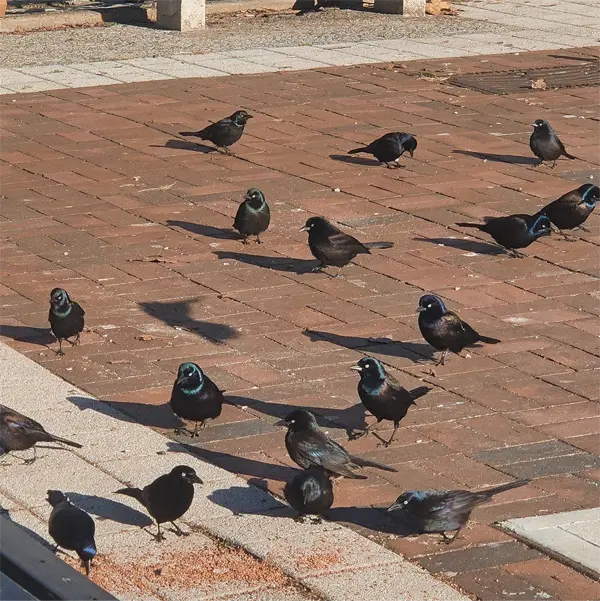
Photo 175678216 © Biana Varga, CC BY-NC
American Crows in Central Florida – Conclusion
With abundant food sources and ideal nesting habitat, American Crows thrive across central Florida’s urban and rural environments. Their intelligence allows them to exploit any opportunity. While American Crows can become a nuisance through droppings, noise, and damage, proactive dispersal, exclusion, and sanitation limits problems.
Understanding American Crow biology and behavior is key to implementing an effective management plan tailored to the situation. Population control traps may be warranted if exclusion fails to resolve a persistent American Crow issue. With an integrated pest management approach focused on prevention, American Crow conflicts can be mitigated humanely and successfully.

